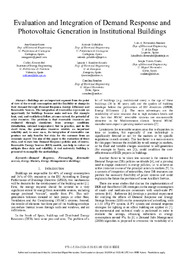Por favor, use este identificador para citar o enlazar este ítem:
https://hdl.handle.net/11000/30988Registro completo de metadatos
| Campo DC | Valor | Lengua/Idioma |
|---|---|---|
| dc.contributor.author | García-Garre, Ana | - |
| dc.contributor.author | Gabaldón, Antonio | - |
| dc.contributor.author | Fernández-Jiménez, Luis A. | - |
| dc.contributor.author | Álvarez-Bel, Carlos | - |
| dc.contributor.author | Ramírez-Rosado, Ignacio J. | - |
| dc.contributor.author | VALERO, SERGIO | - |
| dc.contributor.author | Senabre, Carolina | - |
| dc.contributor.other | Departamentos de la UMH::Ingeniería Mecánica y Energía | es_ES |
| dc.date.accessioned | 2024-02-02T17:30:35Z | - |
| dc.date.available | 2024-02-02T17:30:35Z | - |
| dc.date.created | 2018-09-10 | - |
| dc.identifier.uri | https://hdl.handle.net/11000/30988 | - |
| dc.description.abstract | Buildings are an important segment from the point of view of the overall consumption and the flexibility or change in their demand through Demand Response, Energy Efficiency and Renewable Sources. The integration of renewables represents an opportunity for buildings because main end-uses (for example heat, cool, and ventilation) follow, at some extend, the potential of solar resource. The problem is that renewable resources are evaluated through simulators from average conditions (irradiation, external temperature) but in practice, and in the short term, the generation resource exhibits an important volatility and, in some cases, the integration of renewables can produce not only benefits but risks for the customer from an economic aspect. The aim of this paper is the evaluation of these risks, and to state how Demand Response policies and, of course, Renewable Energy Sources (RES) models, can help to reduce or mitigate these risks and volatility. A real university building is presented to exemplify the methodology. | es_ES |
| dc.format | application/pdf | es_ES |
| dc.format.extent | 6 | es_ES |
| dc.language.iso | eng | es_ES |
| dc.publisher | Institute of Electrical and Electronics Engineers | es_ES |
| dc.relation.ispartof | 2018 International Conference on Smart Energy Systems and Technologies (SEST) | es_ES |
| dc.rights | info:eu-repo/semantics/openAccess | es_ES |
| dc.rights | Attribution-NonCommercial-NoDerivatives 4.0 Internacional | * |
| dc.rights.uri | http://creativecommons.org/licenses/by-nc-nd/4.0/ | * |
| dc.subject | demand response | es_ES |
| dc.subject | forecasting | es_ES |
| dc.subject | renewable sources | es_ES |
| dc.subject | energy markets | es_ES |
| dc.subject | energy management in buildings | es_ES |
| dc.subject.classification | Ingeniería eléctrica | es_ES |
| dc.subject.other | CDU::6 - Ciencias aplicadas::62 - Ingeniería. Tecnología | es_ES |
| dc.title | Evaluation and Integration of Demand Response and Photovoltaic Generation in Institutional Buildings | es_ES |
| dc.type | info:eu-repo/semantics/other | es_ES |
| dc.relation.publisherversion | https://doi.org/10.1109/SEST.2018.8495699 | es_ES |

Ver/Abrir:
Paper 3 Congreso -- Evaluation_and_Integration_of_Demand_Response_and_Photovoltaic_Generation_in_Institutional_Buildings.pdf
982,23 kB
Adobe PDF
Compartir:
 La licencia se describe como: Atribución-NonComercial-NoDerivada 4.0 Internacional.
La licencia se describe como: Atribución-NonComercial-NoDerivada 4.0 Internacional.
.png)